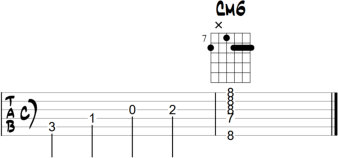
home \ courses \ music theory III \ page 7
The 6 and minor 6 chords
Instead of adding a seventh to a triad, you can add a sixth. When adding a sixth, it is always a major sixth.
You can add a sixth to a major or a minor chord. Let's look at the major 6th first.

So we have C-E-G-A. The "A" is the sixth. This is how this C6 chord sounds:

If you look at the tones C-E-G-A you may notisce something (no problem if you don't!).
If you change the order by putting the "A" at the start, you get: A-C-E-G.
And that is the A minor 7th chord! So C6 and Am7 consist of the same tones! You can say the C6 is an inversion of Am7.
Or you can say that C6 is the same as Am7 with a C in the bass (written like Am7/C).
Amazing, isn't it!
Now let's look at the minor sixth chord:

Here we have C - Eb - G - A.
First, lets listen to this chord:

Now what happens if we change the order the same way, and put the A at thr front? We get:
A-C-Eb-G
And that is the same as the A half diminished chord!
So: Cm6 = A half diminished!
You can use this info when playing guitar. Look at the following example:

The A halfdiminished is used as an alternative to Cm6, which results in a nice voicing.

Everything on guitartutorials.nl is completely free to access. If you’d like to support my work and help keep this resource growing, any and all donations are deeply appreciated. Thank you, and happy playing!